Xingyuan Li
Step-Audio 2 Technical Report
Jul 24, 2025Abstract:This paper presents Step-Audio 2, an end-to-end multi-modal large language model designed for industry-strength audio understanding and speech conversation. By integrating a latent audio encoder and reasoning-centric reinforcement learning (RL), Step-Audio 2 achieves promising performance in automatic speech recognition (ASR) and audio understanding. To facilitate genuine end-to-end speech conversation, Step-Audio 2 incorporates the generation of discrete audio tokens into language modeling, significantly enhancing its responsiveness to paralinguistic information such as speaking styles and emotions. To effectively leverage the rich textual and acoustic knowledge in real-world data, Step-Audio 2 integrates retrieval-augmented generation (RAG) and is able to call external tools such as web search to mitigate hallucination and audio search to switch timbres. Trained on millions of hours of speech and audio data, Step-Audio 2 delivers intelligence and expressiveness across diverse conversational scenarios. Evaluation results demonstrate that Step-Audio 2 achieves state-of-the-art performance on various audio understanding and conversational benchmarks compared to other open-source and commercial solutions. Please visit https://github.com/stepfun-ai/Step-Audio2 for more information.
KAN-SAM: Kolmogorov-Arnold Network Guided Segment Anything Model for RGB-T Salient Object Detection
Apr 08, 2025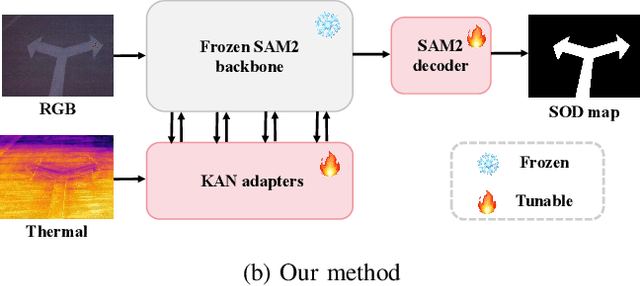
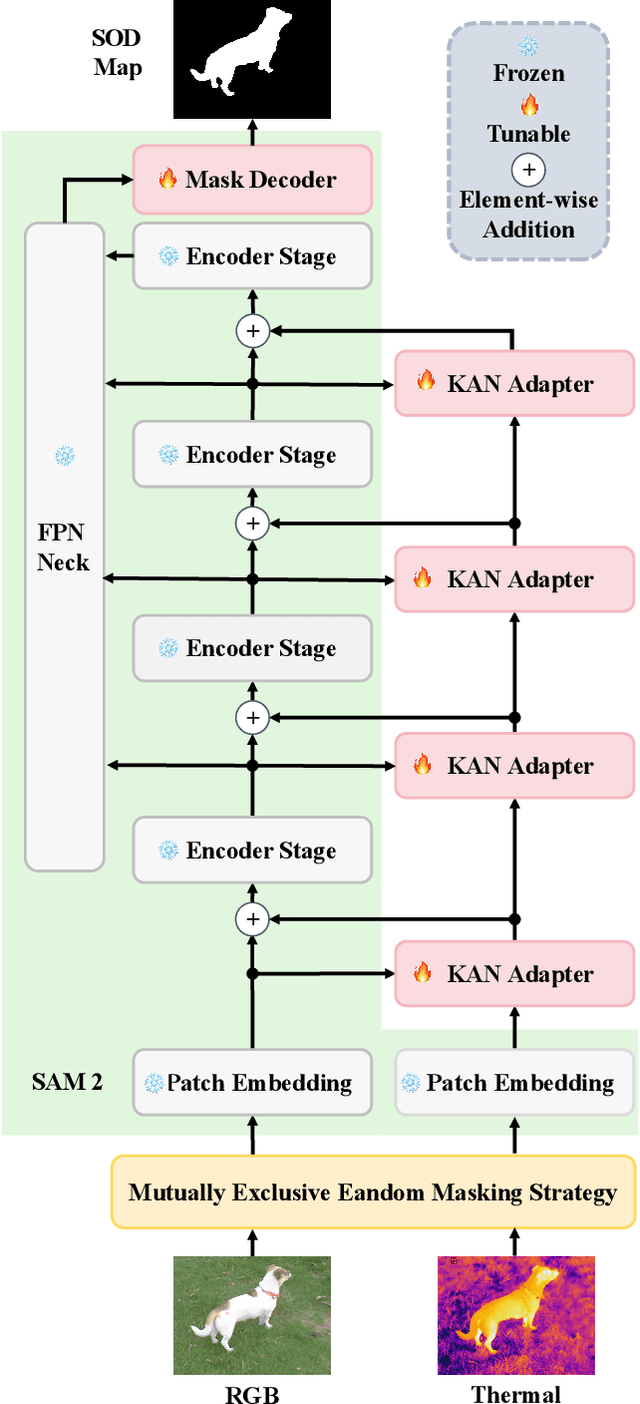
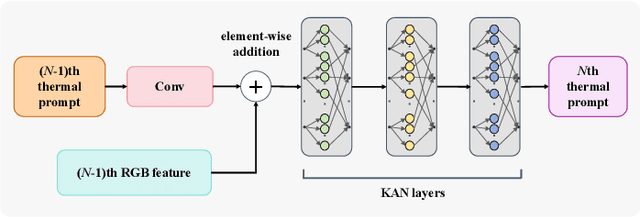

Abstract:Existing RGB-thermal salient object detection (RGB-T SOD) methods aim to identify visually significant objects by leveraging both RGB and thermal modalities to enable robust performance in complex scenarios, but they often suffer from limited generalization due to the constrained diversity of available datasets and the inefficiencies in constructing multi-modal representations. In this paper, we propose a novel prompt learning-based RGB-T SOD method, named KAN-SAM, which reveals the potential of visual foundational models for RGB-T SOD tasks. Specifically, we extend Segment Anything Model 2 (SAM2) for RGB-T SOD by introducing thermal features as guiding prompts through efficient and accurate Kolmogorov-Arnold Network (KAN) adapters, which effectively enhance RGB representations and improve robustness. Furthermore, we introduce a mutually exclusive random masking strategy to reduce reliance on RGB data and improve generalization. Experimental results on benchmarks demonstrate superior performance over the state-of-the-art methods.
AxisPose: Model-Free Matching-Free Single-Shot 6D Object Pose Estimation via Axis Generation
Mar 09, 2025



Abstract:Object pose estimation, which plays a vital role in robotics, augmented reality, and autonomous driving, has been of great interest in computer vision. Existing studies either require multi-stage pose regression or rely on 2D-3D feature matching. Though these approaches have shown promising results, they rely heavily on appearance information, requiring complex input (i.e., multi-view reference input, depth, or CAD models) and intricate pipeline (i.e., feature extraction-SfM-2D to 3D matching-PnP). We propose AxisPose, a model-free, matching-free, single-shot solution for robust 6D pose estimation, which fundamentally diverges from the existing paradigm. Unlike existing methods that rely on 2D-3D or 2D-2D matching using 3D techniques, such as SfM and PnP, AxisPose directly infers a robust 6D pose from a single view by leveraging a diffusion model to learn the latent axis distribution of objects without reference views. Specifically, AxisPose constructs an Axis Generation Module (AGM) to capture the latent geometric distribution of object axes through a diffusion model. The diffusion process is guided by injecting the gradient of geometric consistency loss into the noise estimation to maintain the geometric consistency of the generated tri-axis. With the generated tri-axis projection, AxisPose further adopts a Triaxial Back-projection Module (TBM) to recover the 6D pose from the object tri-axis. The proposed AxisPose achieves robust performance at the cross-instance level (i.e., one model for N instances) using only a single view as input without reference images, with great potential for generalization to unseen-object level.
DifIISR: A Diffusion Model with Gradient Guidance for Infrared Image Super-Resolution
Mar 03, 2025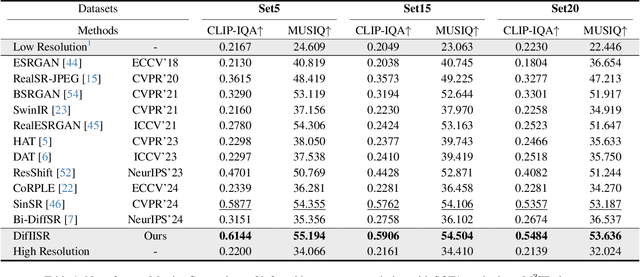
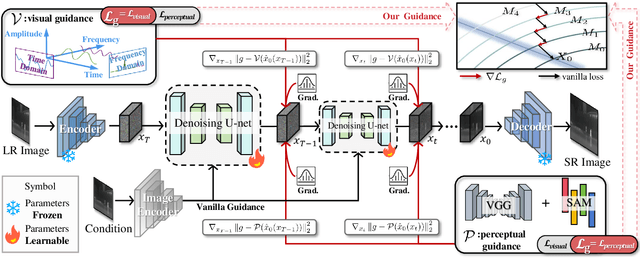

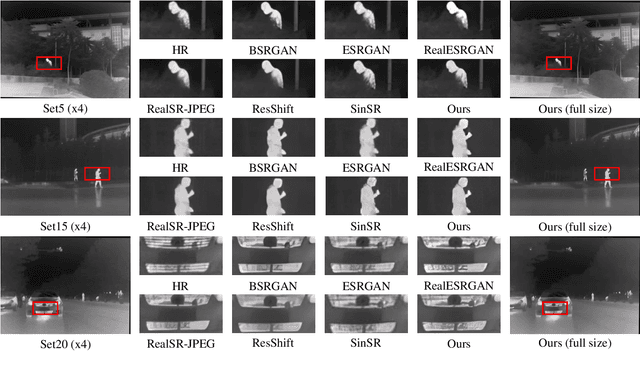
Abstract:Infrared imaging is essential for autonomous driving and robotic operations as a supportive modality due to its reliable performance in challenging environments. Despite its popularity, the limitations of infrared cameras, such as low spatial resolution and complex degradations, consistently challenge imaging quality and subsequent visual tasks. Hence, infrared image super-resolution (IISR) has been developed to address this challenge. While recent developments in diffusion models have greatly advanced this field, current methods to solve it either ignore the unique modal characteristics of infrared imaging or overlook the machine perception requirements. To bridge these gaps, we propose DifIISR, an infrared image super-resolution diffusion model optimized for visual quality and perceptual performance. Our approach achieves task-based guidance for diffusion by injecting gradients derived from visual and perceptual priors into the noise during the reverse process. Specifically, we introduce an infrared thermal spectrum distribution regulation to preserve visual fidelity, ensuring that the reconstructed infrared images closely align with high-resolution images by matching their frequency components. Subsequently, we incorporate various visual foundational models as the perceptual guidance for downstream visual tasks, infusing generalizable perceptual features beneficial for detection and segmentation. As a result, our approach gains superior visual results while attaining State-Of-The-Art downstream task performance. Code is available at https://github.com/zirui0625/DifIISR
Modality Decoupling is All You Need: A Simple Solution for Unsupervised Hyperspectral Image Fusion
Dec 06, 2024Abstract:Hyperspectral Image Fusion (HIF) aims to fuse low-resolution hyperspectral images (LR-HSIs) and high-resolution multispectral images (HR-MSIs) to reconstruct high spatial and high spectral resolution images. Current methods typically apply direct fusion from the two modalities without valid supervision, failing to fully perceive the deep modality-complementary information and hence, resulting in a superficial understanding of inter-modality connections. To bridge this gap, we propose a simple and effective solution for unsupervised HIF with an assumption that modality decoupling is essential for HIF. We introduce the modality clustering loss that ensures clear guidance of the modality, decoupling towards modality-shared features while steering clear of modality-complementary ones. Also, we propose an end-to-end Modality-Decoupled Spatial-Spectral Fusion (MossFuse) framework that decouples shared and complementary information across modalities and aggregates a concise representation of the LR-HSI and HR-MSI to reduce the modality redundancy. Systematic experiments over multiple datasets demonstrate that our simple and effective approach consistently outperforms the existing HIF methods while requiring considerably fewer parameters with reduced inference time.
Contourlet Refinement Gate Framework for Thermal Spectrum Distribution Regularized Infrared Image Super-Resolution
Nov 19, 2024



Abstract:Image super-resolution (SR) is a classical yet still active low-level vision problem that aims to reconstruct high-resolution (HR) images from their low-resolution (LR) counterparts, serving as a key technique for image enhancement. Current approaches to address SR tasks, such as transformer-based and diffusion-based methods, are either dedicated to extracting RGB image features or assuming similar degradation patterns, neglecting the inherent modal disparities between infrared and visible images. When directly applied to infrared image SR tasks, these methods inevitably distort the infrared spectral distribution, compromising the machine perception in downstream tasks. In this work, we emphasize the infrared spectral distribution fidelity and propose a Contourlet refinement gate framework to restore infrared modal-specific features while preserving spectral distribution fidelity. Our approach captures high-pass subbands from multi-scale and multi-directional infrared spectral decomposition to recover infrared-degraded information through a gate architecture. The proposed Spectral Fidelity Loss regularizes the spectral frequency distribution during reconstruction, which ensures the preservation of both high- and low-frequency components and maintains the fidelity of infrared-specific features. We propose a two-stage prompt-learning optimization to guide the model in learning infrared HR characteristics from LR degradation. Extensive experiments demonstrate that our approach outperforms existing image SR models in both visual and perceptual tasks while notably enhancing machine perception in downstream tasks. Our code is available at https://github.com/hey-it-s-me/CoRPLE.
Phonetic and Lexical Discovery of a Canine Language using HuBERT
Feb 25, 2024



Abstract:This paper delves into the pioneering exploration of potential communication patterns within dog vocalizations and transcends traditional linguistic analysis barriers, which heavily relies on human priori knowledge on limited datasets to find sound units in dog vocalization. We present a self-supervised approach with HuBERT, enabling the accurate classification of phoneme labels and the identification of vocal patterns that suggest a rudimentary vocabulary within dog vocalizations. Our findings indicate a significant acoustic consistency in these identified canine vocabulary, covering the entirety of observed dog vocalization sequences. We further develop a web-based dog vocalization labeling system. This system can highlight phoneme n-grams, present in the vocabulary, in the dog audio uploaded by users.
Towards Robust Image Stitching: An Adaptive Resistance Learning against Compatible Attacks
Feb 25, 2024
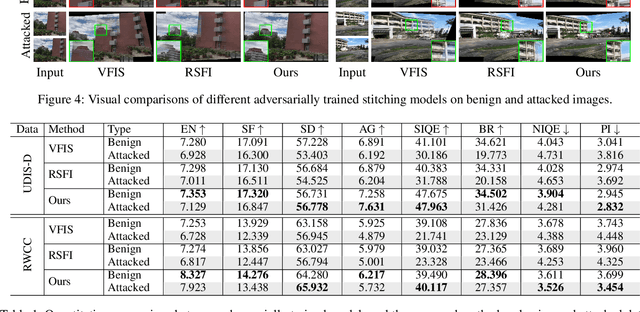


Abstract:Image stitching seamlessly integrates images captured from varying perspectives into a single wide field-of-view image. Such integration not only broadens the captured scene but also augments holistic perception in computer vision applications. Given a pair of captured images, subtle perturbations and distortions which go unnoticed by the human visual system tend to attack the correspondence matching, impairing the performance of image stitching algorithms. In light of this challenge, this paper presents the first attempt to improve the robustness of image stitching against adversarial attacks. Specifically, we introduce a stitching-oriented attack~(SoA), tailored to amplify the alignment loss within overlapping regions, thereby targeting the feature matching procedure. To establish an attack resistant model, we delve into the robustness of stitching architecture and develop an adaptive adversarial training~(AAT) to balance attack resistance with stitching precision. In this way, we relieve the gap between the routine adversarial training and benign models, ensuring resilience without quality compromise. Comprehensive evaluation across real-world and synthetic datasets validate the deterioration of SoA on stitching performance. Furthermore, AAT emerges as a more robust solution against adversarial perturbations, delivering superior stitching results. Code is available at:https://github.com/Jzy2017/TRIS.
From Text to Pixels: A Context-Aware Semantic Synergy Solution for Infrared and Visible Image Fusion
Dec 31, 2023



Abstract:With the rapid progression of deep learning technologies, multi-modality image fusion has become increasingly prevalent in object detection tasks. Despite its popularity, the inherent disparities in how different sources depict scene content make fusion a challenging problem. Current fusion methodologies identify shared characteristics between the two modalities and integrate them within this shared domain using either iterative optimization or deep learning architectures, which often neglect the intricate semantic relationships between modalities, resulting in a superficial understanding of inter-modal connections and, consequently, suboptimal fusion outcomes. To address this, we introduce a text-guided multi-modality image fusion method that leverages the high-level semantics from textual descriptions to integrate semantics from infrared and visible images. This method capitalizes on the complementary characteristics of diverse modalities, bolstering both the accuracy and robustness of object detection. The codebook is utilized to enhance a streamlined and concise depiction of the fused intra- and inter-domain dynamics, fine-tuned for optimal performance in detection tasks. We present a bilevel optimization strategy that establishes a nexus between the joint problem of fusion and detection, optimizing both processes concurrently. Furthermore, we introduce the first dataset of paired infrared and visible images accompanied by text prompts, paving the way for future research. Extensive experiments on several datasets demonstrate that our method not only produces visually superior fusion results but also achieves a higher detection mAP over existing methods, achieving state-of-the-art results.
AdvMono3D: Advanced Monocular 3D Object Detection with Depth-Aware Robust Adversarial Training
Sep 03, 2023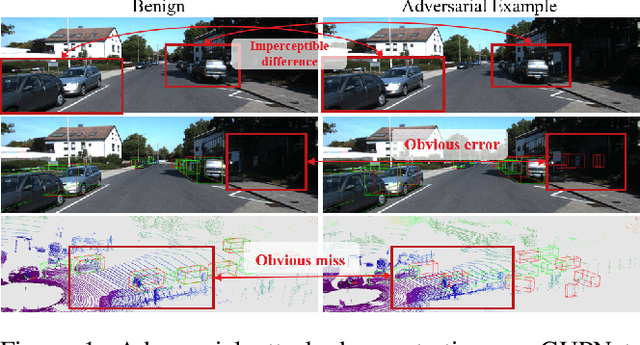



Abstract:Monocular 3D object detection plays a pivotal role in the field of autonomous driving and numerous deep learning-based methods have made significant breakthroughs in this area. Despite the advancements in detection accuracy and efficiency, these models tend to fail when faced with such attacks, rendering them ineffective. Therefore, bolstering the adversarial robustness of 3D detection models has become a crucial issue that demands immediate attention and innovative solutions. To mitigate this issue, we propose a depth-aware robust adversarial training method for monocular 3D object detection, dubbed DART3D. Specifically, we first design an adversarial attack that iteratively degrades the 2D and 3D perception capabilities of 3D object detection models(IDP), serves as the foundation for our subsequent defense mechanism. In response to this attack, we propose an uncertainty-based residual learning method for adversarial training. Our adversarial training approach capitalizes on the inherent uncertainty, enabling the model to significantly improve its robustness against adversarial attacks. We conducted extensive experiments on the KITTI 3D datasets, demonstrating that DART3D surpasses direct adversarial training (the most popular approach) under attacks in 3D object detection $AP_{R40}$ of car category for the Easy, Moderate, and Hard settings, with improvements of 4.415%, 4.112%, and 3.195%, respectively.
 Add to Chrome
Add to Chrome Add to Firefox
Add to Firefox Add to Edge
Add to Edge